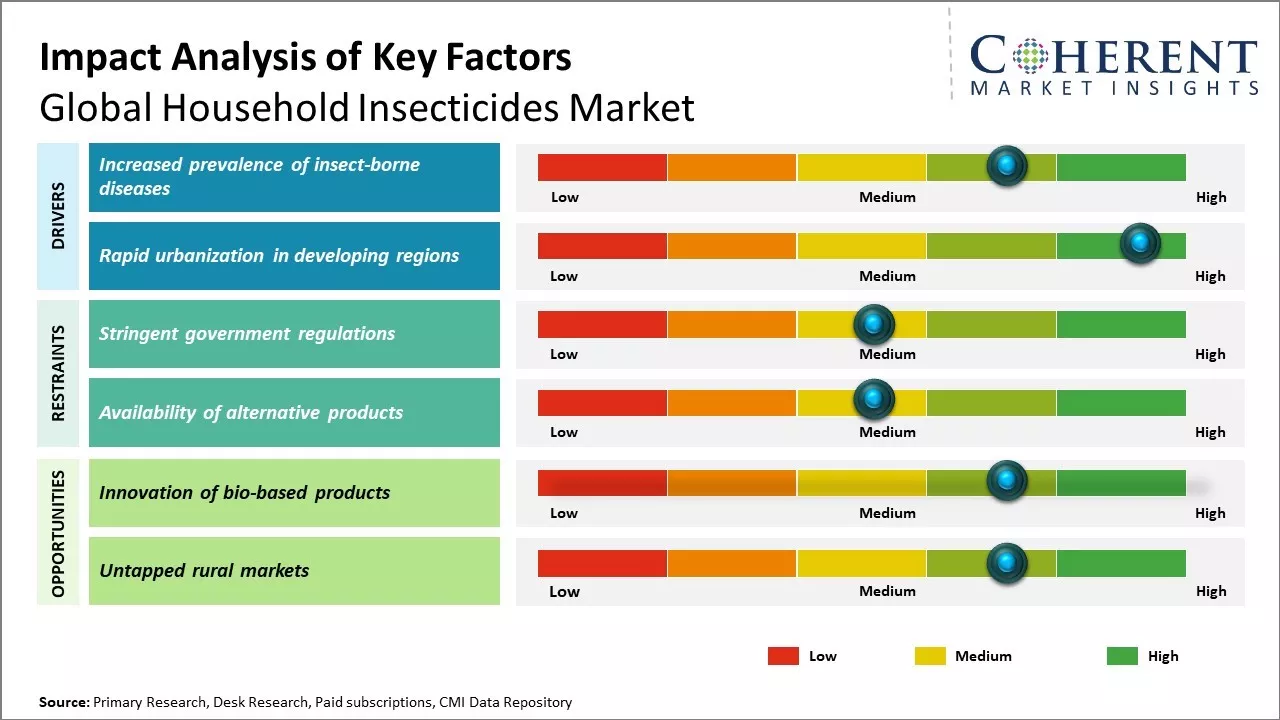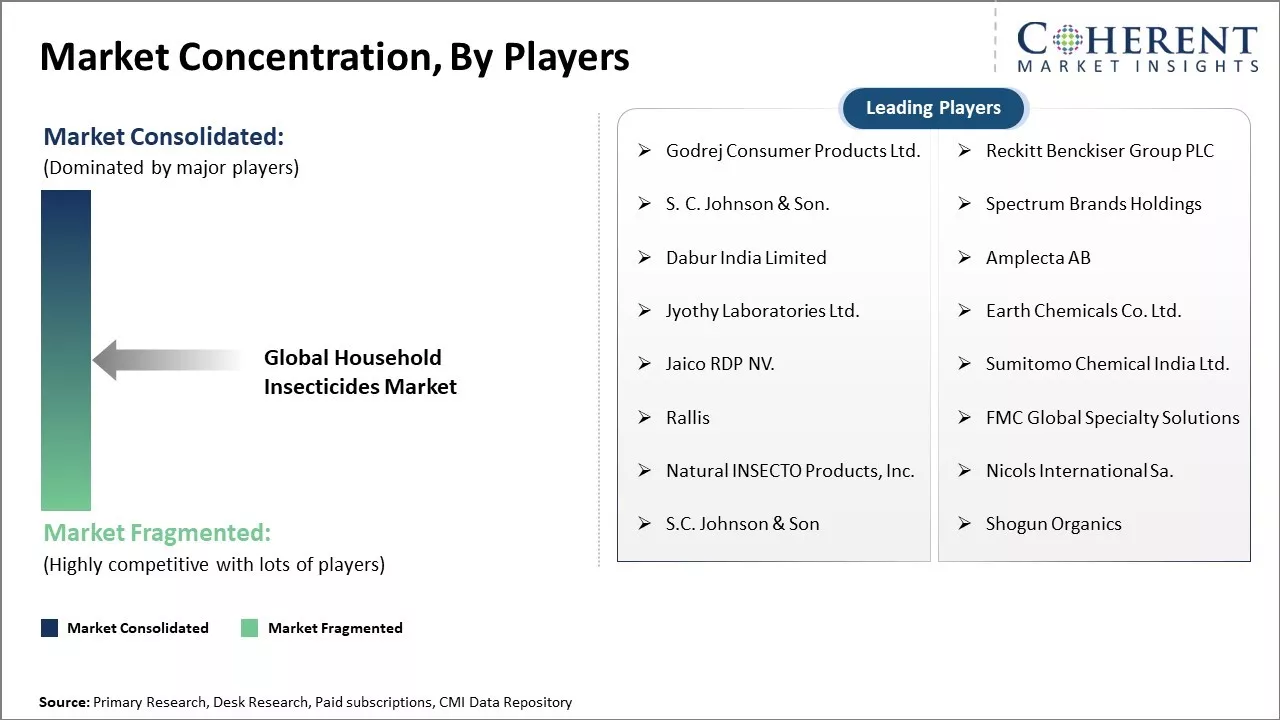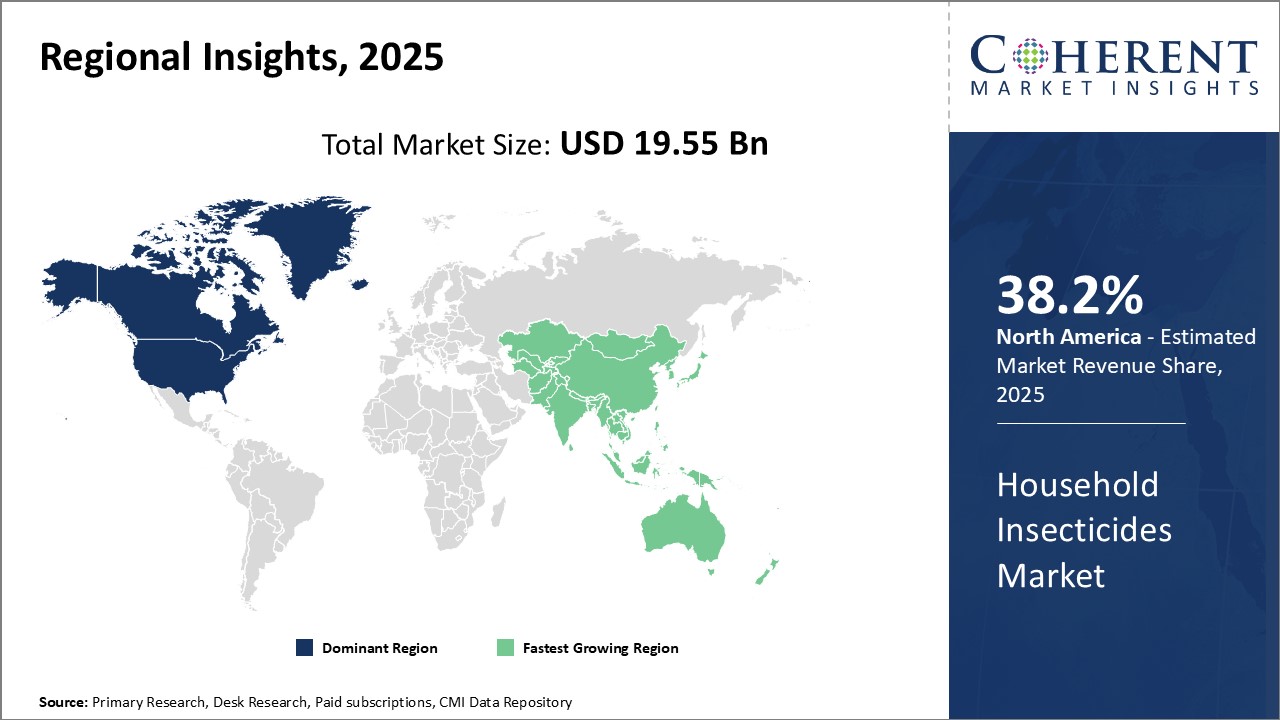The household insecticides market size is estimated at USD 19.55 Bn in 2025 and is expected to reach USD 30.60 Bn by 2032, exhibiting a compound annual growth rate (CAGR) of 6.6% from 2025 to 2032.

To learn more about this report, Download Free Sample
Application: Manufacturers are incorporating Internet of Things (IoT) technology into household insecticide products to enhance convenience and efficiency. Smart insecticide dispensers can automatically release repellents based on motion detection, time settings, or pest activity levels. These devices help maintain consistent protection while reducing unnecessary chemical use.
In February 2024, At PestEx 2024, Trojan Systems showcased their Val-E, an IoT-enabled smart multitrap designed for humane and efficient pest control. This device offers real-time notifications, detailed analytics, and can capture up to 15 mice, providing insights into pest behavior and optimizing intervention strategies.
Application: Microencapsulation technology is being applied to insecticide formulations to allow for the slow and sustained release of active ingredients. This not only extends product effectiveness but also minimizes direct exposure to high concentrations of chemicals.
In November 2023, a study published in Frontiers in Microbiology focused on encapsulating the bacterium Bacillus thuringiensis subsp. kurstaki IMBL-B9 using a mixture of gum arabic, maltodextrin, and corn starch. This formulation enhanced spore survival and stability, leading to improved shelf life and efficacy against pests like Plutella xylostella and Spodoptera frugiperda. The microencapsulation process significantly increased the insecticidal activity of the biopesticide.
Growing awareness of vector-borne diseases such as dengue and malaria and growing need for efficient, affordable, and simple-to-use pest control measures in urban and semi-urban residences boost the demand for preventive insect control, particularly in regions where seasonal outbreaks occur.
Consumers are increasingly favoring green, plant-based insecticides, especially those made with essential oils and herbal extracts. These alternatives are gaining popularity in developed economies such as the U.S., the U.K., Germany, and France, as consumers demand low-toxicity and sustainable options.
However, the market is facing challenges like regulatory scrutiny for chemical composition, rising indoor air quality issues, and requirement for improved product safety and labeling needs.

To learn more about this report, Download Free Sample
|
Current Events |
Description and its impact |
|
Rising Vector-Borne Disease Outbreaks Globally |
|
|
Shift Toward Natural and Eco-Friendly Formulations |
|
Uncover macros and micros vetted on 75+ parameters: Get instant access to report
In terms of type, synthetic segment is expected to contribute 76.1% share of the market in 2025. Due to their low-cost and reliable performance, synthetic insecticides have emerged as the primary choice for most households to protect their homes from insects.
In terms of purpose, mosquitoes and flies control segment is expected to contribute 32.7% share of the market in 2025.
Mosquitoes and flies are among the most common and widely spread pests found in households. The range of options available for quick relief from mosquitoes and flies, with just spray application, makes products under this segment highly convenient to use. Their affordability further drives their adoption. With growing health and hygiene awareness, consumers prefer utilizing fast and targeted solutions to protect themselves and families from flies and mosquito borne diseases.
In terms of packaging, small (50-200 ml) segment is expected to contribute 34.9% share in 2025, as it caters well to households' needs.
Small packs are space-efficient and economical for families with limited storage space and budget. Furthermore, small pack convenience encourages more frequent repurchases and trials of different products. Households thus prefer stocking small pack sizes for regular, supplementary requirements throughout the year.

To learn more about this report, Download Free Sample
North America has dominated the global household insecticides market for many years owing to strong industry presence and consumer awareness in the region. The region is expected to hold 38.2% of the market share in 2025.
The U.S. and Canada have several multinational players that manufacture a wide variety of insecticide products targeting different household pests. Companies such as SC Johnson & Son, Inc., Reckitt Benckiser Group Plc, and others have established strong distribution networks across retail channels to ensure high product availability.
Asia Pacific has emerged as the fastest growing regional market for household insecticides in recent years. Countries like India and China have seen rising consumption due to increasing household incomes, rapid urbanization, and growing awareness about pest control products.
The warm climate also contributes to proliferation of insects throughout the year. Local manufacturers have increased production to meet the growing domestic demand. Imports play a relatively minor role due to sufficient local manufacturing capacity. However, exports from the region have risen steadily.
Indian and Chinese companies leverage their large production scale and competitive cost advantages to export products across Asia Pacific, Africa, and Latin America. E-commerce is also gaining prominence in distribution, allowing rural consumers to easily access a wide assortment of brands online. With favorable demographic and economic trends, Asia Pacific's household insecticides market is projected to continue expanding at a rapid pace.
The U.S. household insecticides market is experiencing consistent growth, fueled by rising urbanization, increasing worry about vector-borne diseases, and a shift towards eco-friendly solutions.
Consumers are gravitating towards organic and natural products, leading to a demand for plant-based ingredient-derived insecticides such as essential oils. The trend is also being fueled by health and environmental concerns, which are compelling companies to come up with new biodegradable and non-toxic alternatives
Technological innovations are also shaping the market with the innovation of intelligent, IoT-integrated pest control devices that offer real-time observation and accurate application. In addition, ease of shopping online has increased product availability, contributing to improved sales.
Despite these encouraging trends, the market suffers from issues like stringent regulatory policies and fierce competition, which may impact profit margins and product innovation. However, growing emphasis on living sustainably and innovative solutions for pest management puts the U.S. household insecticides market in a position of sustained growth.
Household insecticides for indoor use, including sprays, traps, and repellents, typically range from US$ 5 to US$ 30 per unit depending on product type, brand, and volume.
Example: A household using a popular spray insecticide for mosquito control may spend US$ 10–25 per canister (400ml), depending on the active ingredients (e.g., DEET, permethrin) and brand.
Outdoor insecticides, often available in larger quantities (e.g., 1–5L bottles), typically cost between US$ 10 to US$ 50 per unit. These products are formulated to cover larger areas and may include additional benefits such as plant protection.
Example: A garden enthusiast purchasing a 2L bottle of concentrated insecticide may spend US$ 20–35, with pricing varying based on concentration and specific pest targeting (e.g., ants, termites, mosquitoes).
Specialized pest control solutions for bed bugs or termites often come in kits, which range from US$ 30 to US$ 100 or more, depending on the severity of the infestation and the type of solution (e.g., chemical treatments vs. non-toxic solutions).
Example: A homeowner dealing with a termite infestation might spend US$ 40–80 for a DIY kit, while a professional service might charge US$ 300–1,500 depending on the scope of the problem and property size.
Manufacturing costs for household insecticides generally include raw materials, formulation development, and quality control. These costs can range from US$ 1 to US$ 10 per unit, depending on the complexity of the active ingredients and packaging.
Example: A manufacturer of a standard aerosol insecticide may incur production costs of US$ 3–6 per canister, with higher costs for premium products with eco-friendly or natural ingredients.
Packaging costs can range from US$ 0.50 to US$ 2 per unit, depending on packaging type (e.g., plastic bottles vs. eco-friendly options) and design (e.g., printed labels, tamper-proof seals).
Example: A brand that markets eco-friendly insecticides in recyclable packaging may incur higher packaging costs of US$ 1–2 per unit, influencing the overall product price.
Household insecticide manufacturers must comply with regulations set by local authorities (e.g., EPA in the U.S., EU regulations), which can lead to certification and compliance costs ranging from US$ 10,000 to US$ 50,000 per product, depending on the region and the product's active ingredients.
Example: A new insecticide formulated with a natural active ingredient might need to undergo safety and environmental impact assessments, leading to a cost of US$ 15,000–30,000 for certification.
| Report Coverage | Details | ||
|---|---|---|---|
| Base Year: | 2024 | Market Size in 2025: | USD 19.55 Bn |
| Historical Data for: | 2020 To 2024 | Forecast Period: | 2025 To 2032 |
| Forecast Period 2025 to 2032 CAGR: | 6.6% | 2032 Value Projection: | USD 30.60 Bn |
| Geographies covered: |
|
||
| Segments covered: |
|
||
| Companies covered: |
Godrej Consumer Products Ltd., Reckitt Benckiser Group PLC, S. C. Johnson & Son., Spectrum Brands Holdings, Dabur India Limited, Amplecta AB, Jyothy Laboratories Ltd., Earth Chemicals Co. Ltd., Jaico RDP NV., Sumitomo Chemical India Ltd., Rallis, FMC Global Specialty Solutions, Natural INSECTO Products, Inc., Nicols International Sa., and Shogun Organics |
||
| Growth Drivers: |
|
||
| Restraints & Challenges: |
|
||
Uncover macros and micros vetted on 75+ parameters: Get instant access to report
*Definition: The household insecticides market refers to consumer products used to control or kill household pests like insects, rodents, and other organisms. Common household insecticides include sprays, baits, strips and foggers/mists containing chemicals like pyrethroids, organophosphates and others that are toxic to pests. These products are available in various forms like aerosols, granules, and liquids and sold through retail stores, online channels and other convenience outlets for home usage to get rid of ants, cockroaches, bed bugs, mosquitoes, and other insects invading homes.
Share
Share
About Author
Vidyesh Swar is a seasoned Consultant with a diverse background in market research and business consulting. With over 6 years of experience, Vidyesh has established a strong reputation for his proficiency in market estimations, supplier landscape analysis, and market share assessments for tailored research solution. Using his deep industry knowledge and analytical skills, he provides valuable insights and strategic recommendations, enabling clients to make informed decisions and navigate complex business landscapes.
Missing comfort of reading report in your local language? Find your preferred language :
Transform your Strategy with Exclusive Trending Reports :
Frequently Asked Questions
Joining thousands of companies around the world committed to making the Excellent Business Solutions.
View All Our Clients